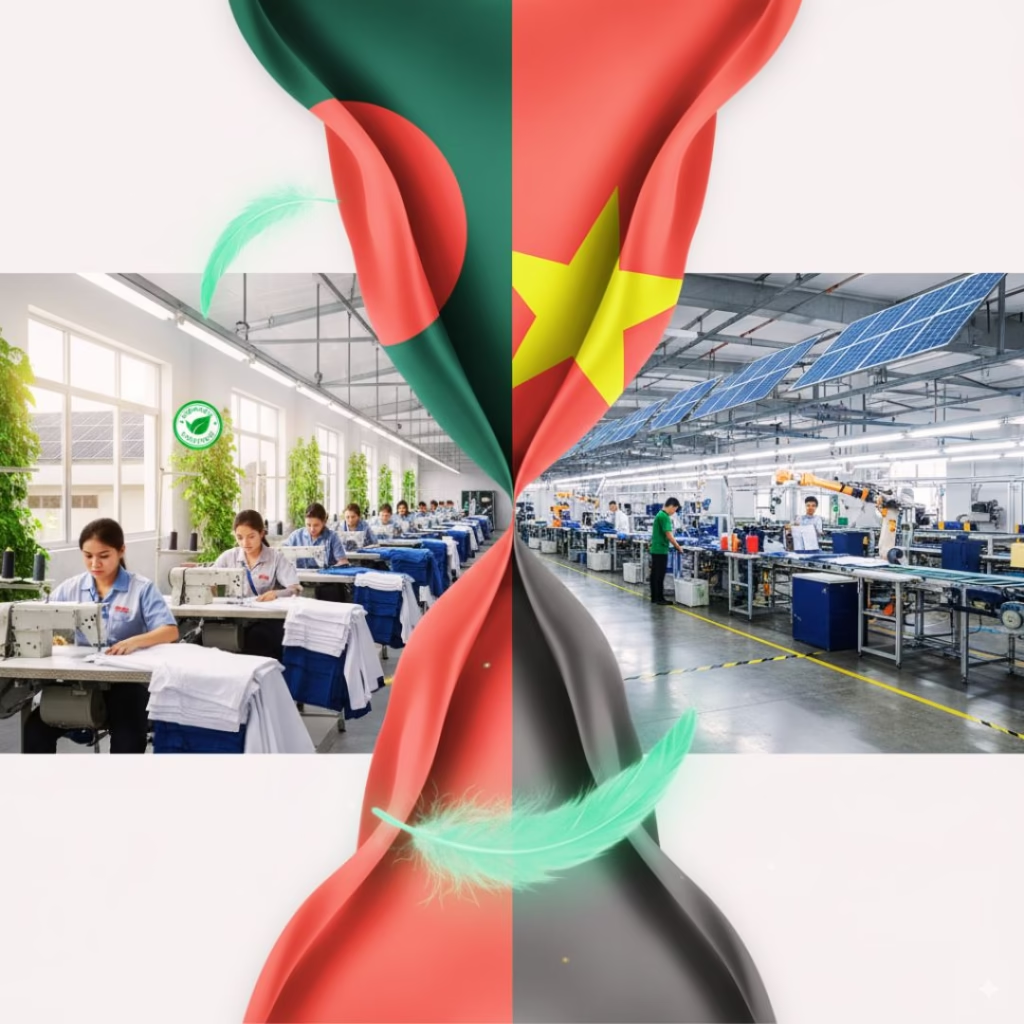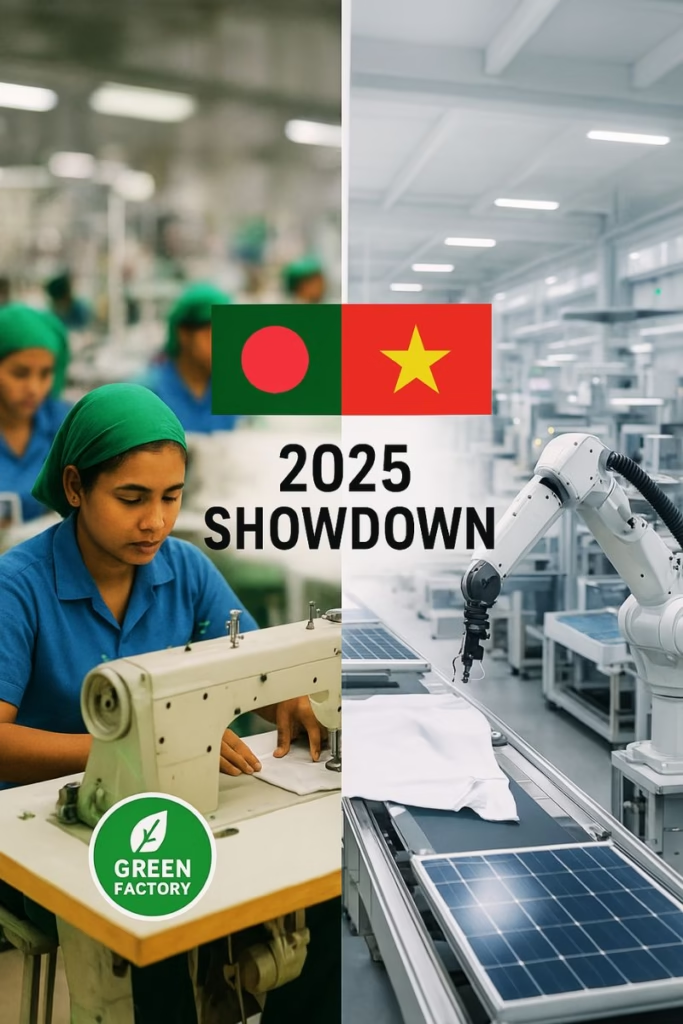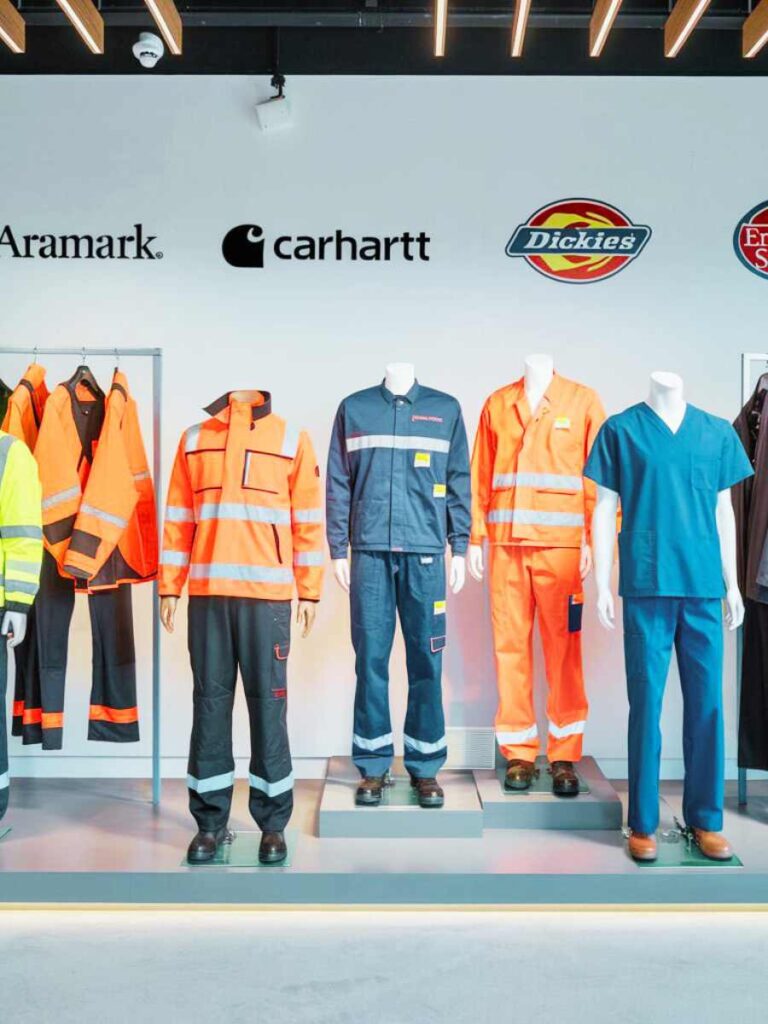The global apparel sourcing landscape continues to evolve rapidly as brands seek the ideal balance between cost, compliance, and quality. In 2025, two giants dominate the conversation: Bangladesh vs Vietnam. Both countries boast sizable manufacturing capacities, competitive labor costs, and improving compliance records. But which truly comes out on top when price and compliance take center stage? In this deep dive, we’ll weigh the critical factors shaping apparel sourcing decisions in 2025, offering actionable insights for importers, wholesalers, and brand owners.
1. Production Cost Comparison
One of the most decisive factors for global buyers is unit cost. Labor and overheads dictate the final price per garment, and even slight differences can dramatically affect margins for large orders.
1.1 Labor Costs
Bangladesh: Hourly garment worker wages average around $0.75–$0.85 USD in 2025, reflecting recent minimum wage adjustments and increased governmental social benefits.
Vietnam: Average hourly wages range from $1.10–$1.20 USD, driven by steady economic growth and rising living standards in major manufacturing hubs like Ho Chi Minh City and Hanoi.
Analysis: Bangladesh retains a clear wage advantage, approximately 30–40% lower than Vietnam. This translates into a meaningful reduction in labor-intensive product costs—especially for basic polo shirts, t-shirts, and outerwear assemblies.
1.2 Overhead & Utility Costs
Energy & Utilities: Vietnam’s power infrastructure investments have stabilized electricity costs at roughly $0.10 per kWh. In contrast, Bangladesh’s rates hover slightly higher at $0.12 per kWh due to ongoing grid expansion efforts.
Facility Leasing: Factory rental rates in industrial zones:
Bangladesh: $3.50–$5.00 per square foot per year
Vietnam: $4.00–$6.00 per square foot per year
Analysis: While Bangladesh leads on labor costs, Vietnam narrows the gap with more efficient utilities, reliable power supply, and modern factory parks that reduce downtime and operational risks.
1.3 Total Landed Cost Illustration
| Cost Component | Bangladesh (per unit) | Vietnam (per unit) |
|---|---|---|
| Labor | $1.10 | $1.55 |
| Utilities & Overhead | $0.25 | $0.20 |
| Logistics & Duty | $0.40 | $0.35 |
| Total | $1.75 | $2.10 |
With freight, insurance, and duties included, Bangladesh offers a roughly 17% lower landed cost for basic apparel categories such as t-shirts and standard uniforms.

2. Compliance & Regulatory Landscape
Cost savings are only valuable if reliability and ethical standards hold. Brands today prioritize robust compliance to mitigate reputational and legal risks.
2.1 Labor Compliance & Social Audits
Bangladesh: Major factory groups have improved fire and building safety after the Rana Plaza disaster of 2013. The Accord and Alliance partnerships continue programs monitoring >1,600 factories. However, worker grievance redressal and unionization remain evolving areas.
Vietnam: The government enforces stricter labor laws aligned with the US-Vietnam Trade Agreement, including clearer provisions for collective bargaining. Over 70% of garment factories now undergo third-party audits such as WRAP, SMETA, or ICS.
Analysis: Vietnam’s regulatory alignment with trade agreements and widespread audit adoption deliver more consistent compliance scores. Bangladesh has made great strides but still grapples with enforcement at smaller, independent factories.
2.2 Environmental Compliance
Bangladesh: Environmental regulations have tightened, requiring effluent treatment plants (ETPs) for dyeing units. However, only an estimated 60–65% of factories meet full wastewater treatment standards.
Vietnam: Approximately 80% of Tier-1 and Tier-2 suppliers maintain ISO 14001 certifications. Government incentives encourage investments in water recycling and renewable energy integration.
Analysis: Vietnam takes the lead on environmental compliance, reducing long-term risks of supply chain disruptions due to regulatory violations or community conflicts.
3. Production Capacity & Lead Times
Price and compliance matter only if factories can meet volume and speed requirements.
3.1 Factory Scale & Infrastructure
Bangladesh: Over 4,500 garment factories, many of which operate 24/7 with organized shift systems. Factory parks near Dhaka and Chattogram support volumes exceeding 4 billion garments annually.
Vietnam: Roughly 3,500 factories, with increasing automation in cut-and-sew and finishing lines. Large conglomerates like Vinatex and emerging private parks in the North and South bolster capacity to over 2.5 billion units per year.
3.2 Lead Times
Bangladesh: Average production lead time (order to ship) is 60–75 days, factoring in high season congestion (Aug–Oct) and port delays in Chattogram.
Vietnam: Slightly faster cycle at 50–65 days on average, thanks to modernized ports in Ho Chi Minh City and better inland transport networks.
Analysis: Vietnam’s infrastructure investments yield tighter lead times, offering brands quicker time-to-market—especially critical for fast-fashion and seasonal collections.
4. Supply Chain Resilience & Diversification
Global risk management demands geographic diversification and reliable multi-tier networks.
4.1 Political & Economic Stability
Bangladesh: Political transitions can trigger intermittent transport strikes, though recent economic policies have focused on export-led growth. Currency volatility remains moderate.
Vietnam: A more stable political environment with proactive trade diplomacy reduces the risk of sudden policy shifts. The dong exhibits steadier performance.
4.2 Supplier Base Diversification
Bangladesh’s ecosystem remains heavily weighted toward RMG (ready-made garments), with nascent technical textiles segments.
Vietnam offers wider upstream integration: fabric mills, accessories, and technical textiles, enabling single-country sourcing for complete product assemblies.
Analysis: Vietnam’s diversified ecosystem enhances resilience, minimizing reliance on cross-border shipments for inputs.
5. Sustainability & CSR Initiatives
Ethical sourcing and sustainability commitments rank high on buyer agendas.
5.1 Renewable Energy Adoption
Bangladesh: Approximately 20% of medium to large factories utilize solar or biogas. However, high capital costs limit broader adoption.
Vietnam: Government targets 30% renewable integration by 2027. Over 35% of major producers report on-site solar installations and energy-efficient machinery.
5.2 Community Engagement & Worker Welfare
Bangladesh: Programs like Better Work Bangladesh partner with the ILO to enhance worker skills, grievance systems, and gender equity.
Vietnam: Vocational training partnerships funded by trade associations improve workforce competency. Patagonia, H&M, and Nike frequently cite Vietnamese factories for CSR best practices.
Analysis: Vietnam’s maturity in sustainability reporting and renewable commitments reflects stronger alignment with leading global brands’ targets.
6. Total Cost of Ownership (TCO) Beyond Unit Price
While unit cost is vital, savvy buyers evaluate the TCO, including compliance risk, speed to market, and brand protection.
| Factor | Bangladesh | Vietnam | Winner |
|---|---|---|---|
| Unit Cost | Lower by ~17% | Higher | Bangladesh |
| Compliance Consistency | Improving but variable | High audit coverage | Vietnam |
| Lead Times | 60–75 days | 50–65 days | Vietnam |
| Environmental Compliance | 60–65% ETP adoption | 80% ISO14001 certified | Vietnam |
| Supply Chain Integration | Strong RMG ecosystem | Full upstream integration | Vietnam |
| Sustainability Initiatives | Growing | Established | Vietnam |
7. Strategic Recommendations for 2025
For brands evaluating Bangladesh vs Vietnam in 2025, consider the following sourcing strategies:
Cost-Driven Core Basics: Leverage Bangladesh for high-volume, low-complexity items (basic tees, polos, bulk uniforms) where price is paramount.
Compliance-Critical & Fast-Fashions: Prioritize Vietnam for complex collections, technical fabrics, or time-sensitive capsule drops.
Dual-Source Approach: Combine both geographies—use Bangladesh for baseline volume, and Vietnam for premium, fast-turn segments. This hedges geopolitical and compliance risks.
Invest in Partnerships: Engage with compliance programs such as the Better Work Bangladesh, Vietnam Apparel Federation, and joint ILO initiatives to elevate standards and secure preferential treatment in global trade agreements.
Monitor Sustainability Metrics: Set clear KPIs around water use, emissions, and renewable energy adoption to drive continuous improvement in both sourcing hubs.
Conclution
In the ultimate Bangladesh vs Vietnam showdown for 2025, there’s no one-size-fits-all winner. Bangladesh continues to offer unbeatable unit cost advantages for high-volume, low-complexity goods. Vietnam, however, pulls ahead on compliance consistency, lead times, and environmental performance—key factors for premium brands and compliance-sensitive categories. The smartest sourcing strategies in 2025 will blend the strengths of both countries, balancing cost savings with ethical standards, speed, and supply chain resilience. Choose the right mix based on your brand’s risk tolerance, product complexity, and sustainability commitments to stay competitive in today’s dynamic apparel market.
Related Links:
Made in Bangladesh vs Made in USA Workwear – Quality Comparison
World Bank report on Bangladesh garment sector
How Vietnam is Challenging Bangladesh in RMG Export? – https://www.youtube.com/watch?v=mz5KcuE-vcw




